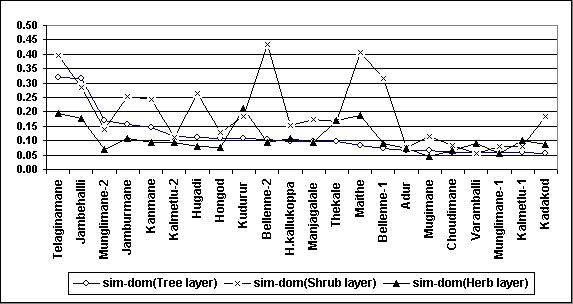DISCUSSION
A total of 93 tree species were enumerated from 22 transects with vegetation type ranging from evergreen forests to moist deciduous mostly in the eastern part of Sagar and Hosanagar taluk having higher human pressure. Some of the localities like Adur, Jambehalli and Kelaginamane have isolated forest patches that are surrounded by cultivated lands and human habitations. Seven evergreen (≥ 80% evergreenness), 8 semievergreen (≥ 60% evergreenness) and 7 moist deciduous (≥ 40% evergreenness) forest habitats were studied. Except in Kudurur, Thekale, Hongod, Choudimane, Manjagalale, Bellene and Kalmetlu in all other places the opened areas are being slowly overgrown by the common weed Eupatorium divergens. Some of the common species observed in more than six localities were Actinodaphne hookeri, Aglaia anamallayana, Aporosa lindleyana, Cinnamomum macrocarpum, Diospyros assimilis, Diospyros candolleana, Canarium strictum, Knema attenuata, Garcinia morella, G.cambogia, Alstonia scholaris, Artocarpus hirsutus, Mimosops elengi, Mangifera indica, Symplocos beddomii, Syzigium Sp, Ficus Sp., Holigarna arnottiana, H. grahmii, Ixora parviflora, Lagerstroemia microcarpa, Olea dioca, Macaranga peltata etc. were common species in evergreen and semievergreen forests and Xylia xylocarpa, Grewia sp, Terminalia Sp, Diospyros montana, etc. along with Bambusa Sp. were common species observed in moist deciduous forests. The floristic richness is not very high for tree diversity (94 species) compared to data for trees ≥c. 30 cm in Asia (198 species in 1.81 ha in Sabah, 214 species in 1 ha in Saravak and 244 species in 2 ha in Malaysia), but closer to the values obtained in some African forests (50 species in 4.05 ha in Nigeria and 120 species in 2 ha in Ghana) (Kessler, 2001). Considering, the PEn for trees for entire locality is 25 with total endemics of 26 species, it is not so high compared to other studies done in Western Ghats in the endemism pattern of southern Western Ghats (Pascal and Pellisier, 1996), endemics represented 48% of the total number of tree species, placing this forest in an intermediate position and endemism could be as high as 63% (for trees ≥ 10 cm DBH). The species number increases from tree layer to herb layer, which may be due to the addition of tree saplings in shrub layer (along with shrubs) and tree and shrub seedlings in herb layer (along with herbs).
Basal area
Species like Mimusops elengi, Diospyros crumenata, Holigarna arnottiana and many Ficus sp. have contributed to the high basal area of Adur. One of the reasons for this higher basal area may be due to the presence of a deity that is worshipped by the local villagers wherein people generally don’t axe the tree for the fear of deity. However, in recent times, with dwindling resources, as it is in the midst of human habitation and cultivation there has been a lot of damage done to this forest also. The case with other high basal area localities is that they are protected under the state forest. But even the lower basal area localities like Jamburmane and Varamballi come under the State forests. Hence it seems that forest conservation depends on the ‘extent’ of protection provided by both the forest department and the local people.
PEv, PEn, and diversity in three layers
PEn is high in evergreen and semievergreen forests compared to the moist deciduous forests. This shows the favorable conditions, which these forest types harbor to produce such a large number of endemics thereby increasing their ecosystem value. Like the evergreen and semievergreen forests that are rich in endemics, moist deciduous forests are rich in timber yielding species which has made them vulnerable to human exploitation that has further reduced both diversity and total basal area. In many of the moist deciduous forests the herb layer composition is highly dominated by the weed Eupatorium divergens, which starts encroaching the forest where there is large scale destruction and openings. This weed domination is as high as 35% in Maithe under herb layer with no seedlings of evergreen trees regenerating. However, in tree layers, species such as Litsea sp., Knema attenuata, Memycelon talbotii, Olea dioca etc, found. In other localities this weed domination is 51.7% in Kelaginamane, 47% in Hugadi, 62% in Maithe, 44.6% in Kanmane, and 45.3% in Jambehalli in Shrub layer. Even though the herb layer may be rich in overall layer diversity, if one considers only the richness of tree seedling regeneration, it appears that it is decreasing in shrub and herb layer. This can be seen from Mugimane where there are 22 tree species in tree layer and comes down to 16 species of tree saplings in shrub layer, and marginally in herb layer by 15 species of tree seedlings. Of course this depends on various edaphic, topographic and anthropogenic factors where the last one may be more important. In most of the deciduous forests Xylia xylocarpa along with Terminalia paniculata dominates in the eastern part, mostly found along with Grewia and Bamboo sp., and slowly decreases as one moves west of Sagar and Hosanagar taluks. In most of the hilly forest areas the shrub layer is mostly dominated by Psychotria flavida in Kudurur (37.5), Thekale (30.2), Hongod (19.7), Manjagalale (30.6) and Bellenne-2 (63.9), and in Bellenne-1 (54.6) (Figure 7) there is increased overall dominance of shrub layers. The other shrub, which is also found in higher numbers in these localities, is Dichapetalum gelonioides. Hence, these places also show higher Simpson dominance. Higher dominance value also correlates with higher IVI as seen for Xylia xylocarpa, Terminalia paniculata and other species. However, these also come under the preferred species for fuel and timber wood species.
Figure 7. Simpson dominance in Tree, Shrub and Herb layers
